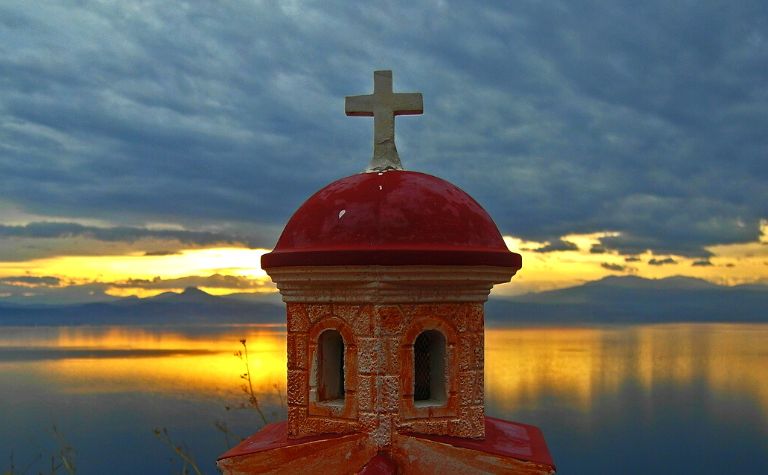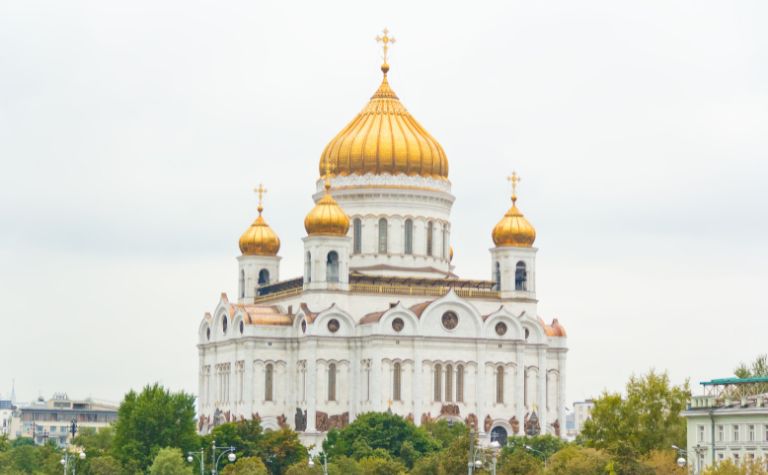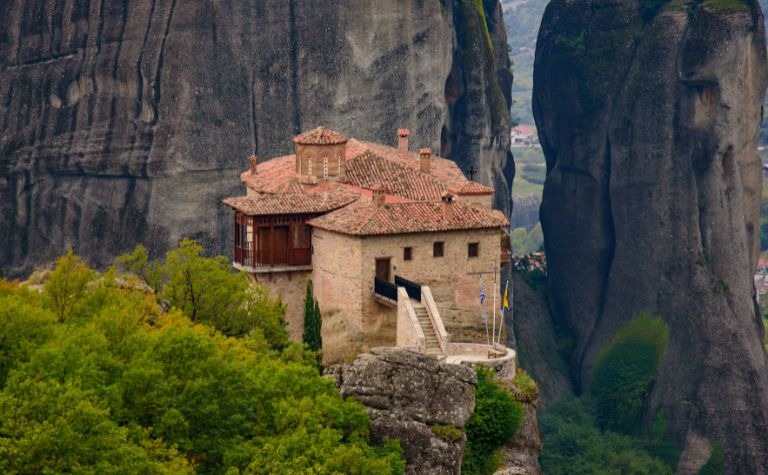Jesus Christ prayed that his followers would be one (John 17:22). Sadly, Christian history shows that sometimes political, ecclesiastical, and theological discord have stood in the way of such unity. A “schism” is a major division in the church. One of the most significant divisions, called the “East-West Schism,” occurred in 1054 A.D.
The three causes of the Great Schism of 1054 A.D. between East and West were:
- Whether the Holy Spirit proceeds from the Father or the Father and the Son.
- Whether the pope is a leader in the church or if he has ultimate authority.
- The number of legitimate ecumenical councils.
What is the filioque clause, and why was it so controversial? What did the East believe about the role of the pope? What are ecumenical councils, and why were some divisive? How do Eastern Orthodoxy and Roman Catholicism compare today? Keep reading to learn the answers to these questions and others.
Also see Who Is the Founder of Christianity? to learn more.

Disunity in 1054 A.D.: The East-West Schism
The traditional date of the East-West Schism is 1054 A.D. because that’s when rival factions excommunicated each other, but disagreements over key issues had been growing for centuries.
The “East” refers to the Greek-speaking Orthodox Church, whose capital was Constantinople. Today it’s called “Eastern Orthodoxy” or the “Eastern Orthodox Church.” The “West” refers to the Latin-speaking Catholic Church, whose capital was Rome. Today it’s called “Roman Catholicism” or the “Roman Catholic Church.”
What is the filioque clause controversy?
The filioque controversy relates to the doctrines of Jesus Christ and the Holy Spirit as the Nicene Creed of 325 A.D. expresses them. The Latin word filioque means “and the son.” The East and West disagreed on whether the Creed should say that Holy Spirit proceeds from the Father (the Eastern Orthodox view) or the Father “and the son” (the Romand Catholic view, and later, the Protestant view).
The Nicene Creed was one of the church’s most important belief statements in the first few centuries. It described what Christians affirm about essential doctrines of the faith and implied the error of rival teachings.
The Creed originally stated that the Holy Spirit proceeds from the Father. The West added the phrase “and the Son” to the Creed at the Synod of Toledo in 589 A.D. The East didn’t participate in the Synod and strongly disagreed with adding the phrase to the Creed. The tension between East and West grew because of the disagreement, which became a reason for their split.
Is the pope the head of the church?
The West, i.e. Roman Catholicism, believes that the pope is the head of the Church in the West, East, and everywhere else. The Catholic Church teaches that Jesus established the office of the pope during his ministry on earth, citing verses like Matt. 16:18-19, Luke 22:31-32, and John 21:15-17 to support their view. Eastern Orthodoxy and Protestant Christianity disagree with the Catholic interpretation of these texts.
Eastern Orthodoxy believes that Jesus is the head of the church. The Orthodox Church thinks people should honor the pope but doesn’t believe he has ultimate authority.
How many ecumenical councils are legitimate?
During Christianity’s first 1,500 years, leaders organized ecumenical councils to unite the church in doctrine and defend the Bible’s teaching. The word “ecumenical” refers to several different Christian churches. First, Christian leaders would gather in a specific location to debate, discuss, and defend the Bible’s teachings. Then, councils expressed their conclusions in writing.
According to the Eastern Orthodox Church, there have been seven legitimate councils. The Roman Catholic Church accepts 21. The Orthodox Church disagreed with the content of the eighth council, and so it was viewed as illegitimate. After the Great Schism, the Catholic Church continued to have councils, which the Orthodox Church doesn’t recognize.
| Ecumenical Council | Orthodox View | Catholic View |
|---|---|---|
| 1. The First Council of Nicaea (325) | accepts | accepts |
| 2. The First Council of Constantinople (381) | accepts | accepts |
| 3. The Council of Ephesus (431) | accepts | accepts |
| 4. The Council of Chalcedon (451) | accepts | accepts |
| 5. The Second Council of Constantinople (553) | accepts | accepts |
| 6. The Third Council of Constantinople (680–681) | accepts | accepts |
| 7. The Second Council of Nicaea (787) | accepts | accepts |
| 8. Fourth Council of Constantinople (869–870) | rejects | accepts |
| 9. First Council of the Lateran (1123) | rejects | accepts |
| 10. Second Council of the Lateran (1139) | rejects | accepts |
| 11. Third Council of the Lateran (1179) | rejects | accepts |
| 12. Fourth Council of the Lateran | rejects | accepts |
| 13. First Council of Lyon (1245) | rejects | accepts |
| 14. Second Council of Lyon (1274) | rejects | accepts |
| 15. Council of Vienne (1311–1312) | rejects | accepts |
| 16. Council of Constance (1414–1418) | rejects | accepts |
| 17. Council of Basel, Ferrara and Florence (1431–1445) | rejects | accepts |
| 18. Fifth Council of the Lateran (1512–1517) | rejects | accepts |
| 19. Council of Trent (1545–1563) | rejects | accepts |
| 20. First Council of the Vatican (1869–1870) | rejects | accepts |
| 21. Second Council of the Vatican (1962–1965) | rejects | accepts |
Also see How Did Christianity Spread? to learn more.

Eastern Orthodoxy and Roman Catholicism Compared
| Roman Catholicism | Eastern Orthodox | |
|---|---|---|
| Name | The word “Roman” is derived from the city of Rome, Italy. The word “catholic,” in general use, means “universal.” In the phrase “Roman Catholic,” Catholic refers to the worldwide collection of churches in the Catholic tradition. | “Eastern” refers to the geographical area of the Orthodox tradition, whose capital was Constantinople. The “Western” church refers to Roman Catholicism, whose capital was Rome. “Orthodox” comes from a Greek word meaning “correct belief.” |
| Founding | Catholicism teaches that its origins are the origins of the church in the first century. The office of the pope, as Vicar of Christ, started with the Apostle Peter. | In 1054 A.D., a split occurred between the Eastern and Western churches. The division is commonly referred to as the East-West schism. The West was Catholic. The East was Orthodox.* |
| Early contributors | In addition to Peter, Paul, and the other Apostles, the first bishops of Rome, the early church fathers, including Ignatius of Antioch (died 108 AD, according to Eusebius) and Irenaeus (130-202 AD), are considered early influencers. | Early influencers in the Orthodox Church include Patriarch Michael I Cerularius of Constantinople (1000-1059), and the so-called Three Pillars of Orthodoxy: Photios I of Constantinople (810-893), Mark of Ephesus (1392-1444), and Gregory Palamas (1296-1359). |
| Membership | The Catholic Church reports a global membership of over 1.3 billion people. Catholicism, though rooted in the Western world, is ethnically diverse today. | The Orthodox Church reports a global membership of 220 million worldwide, making it the smallest of the three historic branches. Though the church originally consisted mostly of Greek people, today it’s largely made up of people with Slavic origins (e.g. Russian, Ukrainian, Polish, etc.). |
| Ecumenical Councils | The Roman Catholic Church recognizes and accepts all 21 ecumenical councils. | The Orthodox Church accepts the first seven ecumenical councils of the 4th through 8th centuries. |
| Social worldview today | The Catholic Church is generally considered conservative in the context of the socio-political landscape of the 21st-century Western world. | The Orthodox Church is conservative theologically and socially, according to conventionally accepted, modern-day definitions of the term. |
Also see Who Was the First Christian Martyr? to learn more.

Theological Similarities and Differences Between East and West
| Roman Catholicism | Eastern Orthodox | |
|---|---|---|
| View of the Bible | The Catholic Church teaches that the Bible is the inspired Word of God. The Catholic Bible includes the deutero-canonical literature or Apocrypha in their Old Testament (e.g. Tobit, Judith, Wisdom of Solomon). | The Bible is the source of doctrine and practice in Eastern Orthodoxy. Orthodox churches include the deutero-canonical books or Apocrypha in their Old Testament. It also includes books like 1 Esdras and Psalm 151, which appear in the Septuagint. |
| View of God | The Catholic Church teaches that God is Triune. The Father, Son, who is Jesus Christ, and the Holy Spirit, are each fully God. | Eastern Orthodoxy believes that God is Triune, but unlike Catholicism and Protestantism, it does not believe that the Holy Spirit proceeds from the Father and Son, but only from the Father. |
| View of Christ | The Catholic Church believes that Jesus of Nazareth is the incarnated second person of the Trinity. He was virgin-born, sinless in life, and died for the sins of humanity. Jesus physically rose from the dead and ascended into heaven. | The second person of the Trinity became a man in the person of Jesus of Nazareth, according to Orthodox beliefs. Jesus was virgin-born and lived a sinless life. The Orthodox Church affirms the historical, physical resurrection of Christ from the dead. |
| View of Salvation | Catholicism teaches that God imparts grace to people through the sacraments. In Catholic theology, justification includes forgiveness, regeneration, and sanctification. Sanctification refers to a person’s progressive growth in holiness and Christ-likeness. | The Orthodox view of salvation is based on 2 Peter 1:4 (see below) called “deification,” which refers to a process of becoming more like God. Deification does not mean that believers will become exactly like God in his essence. |
| View of the Holy Spirit | The Holy Spirit is the third person of the Trinity. He is fully divine. The Spirit indwells Christians and gives them spiritual gifts for the edification of the Church. Catholicism believes the Holy Spirit proceeds from the Father and the Son. | The Holy Spirit is the third person of the Trinity and is fully God, according to Orthodox teachings. The Spirit is distinct from the Father and the Son. “Christ sends the Holy Spirit who proceeds from the Father,” according to Orthodox teaching. |
| Human Leader | The Pope is the Vicar of Christ and the head of the Church on Earth, an office that church teaching traces to the Apostle Peter. | The Ecumenical Patriarch of Constantinople on the head of the Orthodox Church. The Orthodox Church honors the Catholic pope but doesn’t recognize the office as having ultimate authority. |
| Rites | Called “Mass,” meaning “to send” in Latin, is centered on the Eucharist, which the Catholic Church teaches is the “source and summit of the Christian life.” | Called “The Divine Liturgy,” the length of the service, the use of incense, as well as images and symbols characterize the liturgy in Orthodox churches. |
| View of the Ordinances or Sacraments | There are seven sacraments in Catholicism: (1) adult and infant baptism, (2) confirmation, (3) the Eucharist, (4) penance, (5) anointing, (6) ordination, and (7) marriage. These practices are channels of God’s grace, according to Catholic theology. | The Orthodox Church prefers the term “sacred mysteries.” Orthodox teaching conventionally lists seven: communion, baptism, Chrismation, confession, unction, matrimony, and ordination. |
| View of the Lord’s Supper | The “Eucharist,” meaning “to thank,” is a memorial in which the bread and cup become the body and blood of Christ. The change in the nature of the elements is called transubstantiation. | The Orthodox Church teaches that the bread and cup literally turn into the body and blood of Christ, but it does not attempt to explain exactly how it occurs. |
| View of the Baptism | Sometimes referred to as “paedobaptism” (paedo = “child”), according to Catholic teaching, children of Christian parents are baptized to cleanse them of original sin and regenerate them. | Bishops and priests administer baptism, in which subjects are immersed three times, once for each member of the Trinity. Eastern Orthodoxy teaches that baptism regenerates a person and makes them a member of the true church. |
| Icons | The Roman Catholic Church has icons. People use them in different ways to enhance their devotion. Some historians argue that icons in Catholicism have never had the same importance that they do in the Orthodox Church. | The Eastern Orthodox tradition, throughout its history, has strongly defended the use of icons, which they believe enhance people’s devotion to God. |
| View of the end times | The Catholic Church affirms the Second Coming of Christ. The church’s eschatology is amillennial. | Eastern Orthodoxy believes in the return of Christ but does not have a fully developed eschatology as many Protestant traditions do. This is due in part to the Orthodox church believing that the book of Revelation is a mystery. |
Also see What Does Judeo-Christian Mean? to learn more.
References:
[1] Source
[2] Source
Related Questions
The rapid spread of Christianity in the first few centuries after Jesus Christ is one of the most miraculous stories in world history. The incredible expansion of Christianity is rooted in its...
The founder of a religion or faith is the person who started and established it. Knowing who found a belief system and its accompanying way of life helps followers and observers to understand its...
